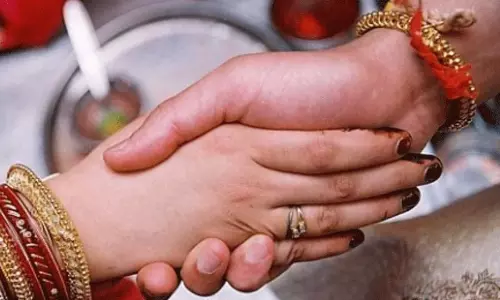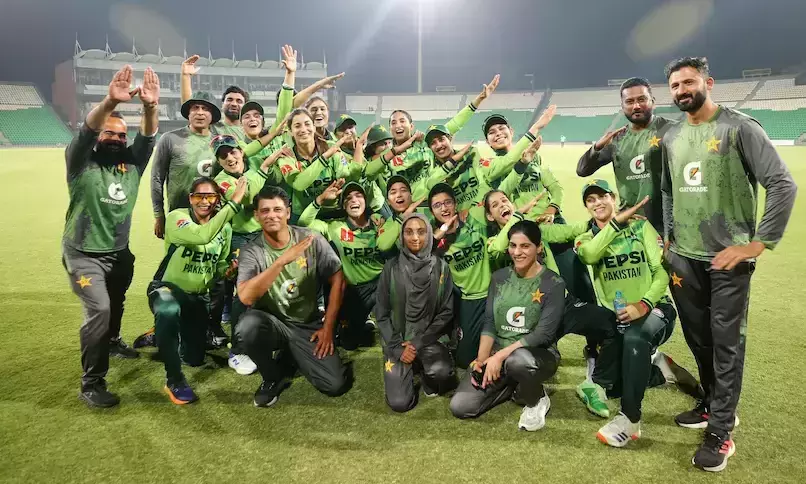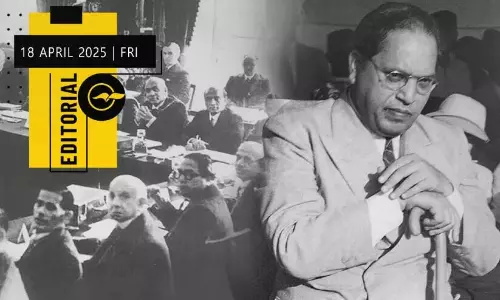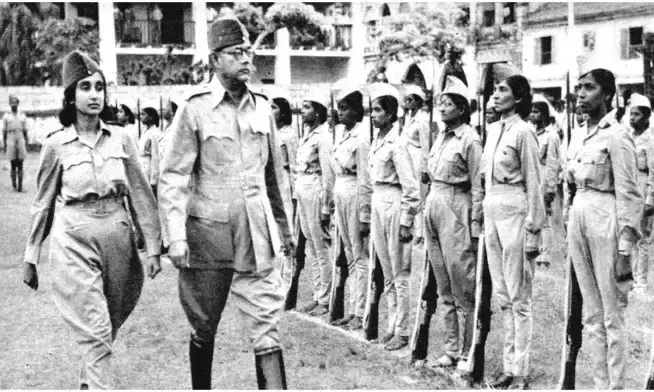
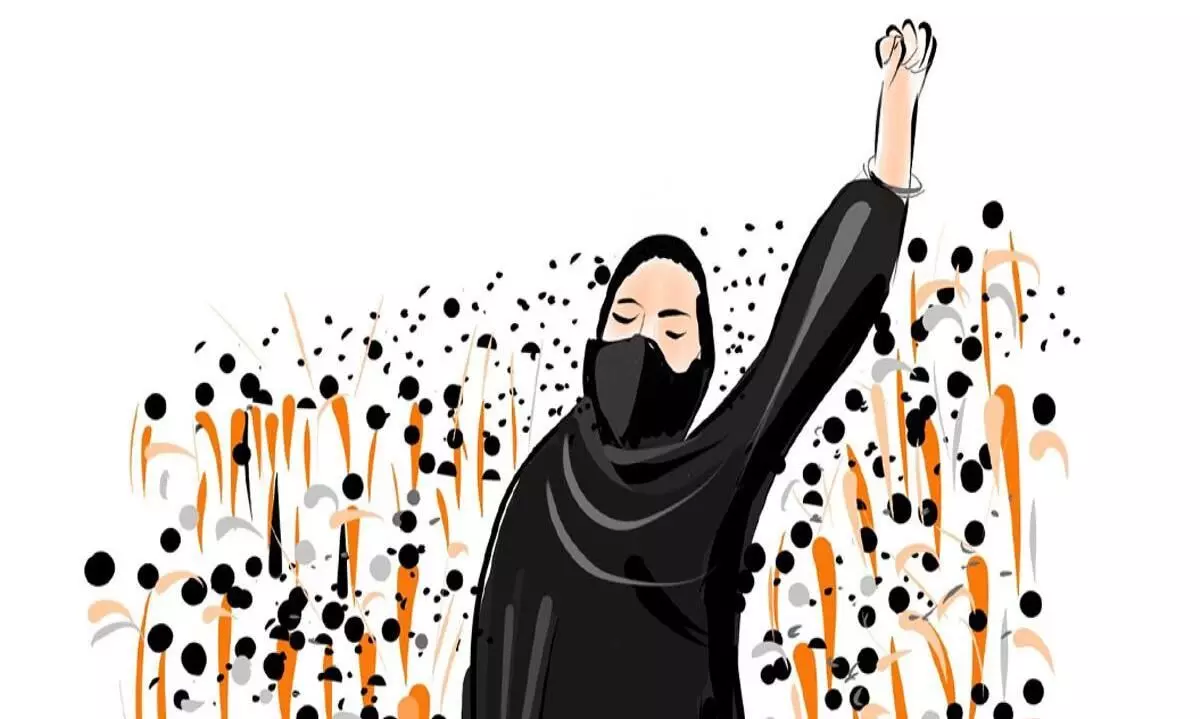
Muskan, the citizen, and her compatriots
text_fieldsThe Karnataka Hijab row that started in a Udupi government Pre-University College spread to campuses in different parts of Karnataka and created very persuasive optics of the 'Us-Jai Shri Ram-Hindus' versus ' them-Hijabi Muslims' on the eve of the Uttar Pradesh state elections. High-octane prime-time debates pushed aside reflections on high inflation and low socio-economic justice under the Yogi government. Under the emergent scenario, it will now require a rare clarity and maturity in the minds of voters to keep him-/herself above casting an unreasoning and communally polarized vote in the Uttar Pradesh elections that got underway last week.
A triumphant picture of Prime Minister Modi and Uttar Pradesh Chief Minister Yogi Adityanath holding hands raised high in the air, shared to the press a couple of hours before the first phase of voting in UP, exuded confidence that not just the UP assembly elections, but even 2024 has already been served on a platter.
The communal spark between Hindus and Muslims got ignited when a government Pre-University College in Udupi brought out a circular prohibiting entry into classes for students wearing the hijab (following the Islamic tradition by which a Muslim woman covers her head when she is with people other than close male relatives). In the week when the campaign of not letting in Muslim students spread to other parts of the state, heated discussions scattered the debate in all directions.
Indian Muslims, born and brought up on Indian soil, much like the Jewish citizens of Germany in the 1930s are pushed to the peripheries of society. Yet the 'Innocent', 'Secular', 'Democratic' Nation Wants to Know: Why didn't Muskan Khan of Mandya shout a secular slogan? Why 'Allahu Akbar'? When BBC News asked her why she called out 'Allahu Akbar', Muskan said: "I was scared. Saying Allahu Akbar gives me courage in times of fear."
The girl who calmly came to submit her assignment despite the hate rhetoric, didn't seem so surprised to see the 40-strong Hindutva gang inside her college campus as the TV viewers across the nation were - at witnessing her composure. The possibility of a Hindutva crowd descending with murderous intent is a reality for which each Indian citizen bearing a Muslim name or observing its practices has braced her/himself for in the seven and a half years of Modi rule. If anything, Muskan's shout 'Allahu Akbar' can be seen as the fortitude of a young Indian citizen hailing from a hounded minority community, who was perhaps determined to go down fearless.
Citizens like Muskan, 24x7 visualise herself/himself as the next hate crime statistic in her country but they still have to go about their daily business - of exams and other things. Arun Karthik essays this theme in his award-winning 2020 Tamil movie 'Nasir'. In an interview given to Scroll, he states: The character of Nasir is the portal through which the web of the everyday stands before us defenceless and vulnerable. Nobody is safe anymore. If you are a minority carrying your religious identity, then even more so."
It should be noted that 'Nasir' which poignantly portrays the life of an Indian Muslim, was made by Arun Karthik, a Hindu, and was based on a short story titled A Clerk's Story written by Dilip Kumar, again a Hindu. Similarly Muskan's college principal and teachers from other religions, the democrats of India, rushed out to comfort her saying all that just happened was not in their name and that she could come to college in the dress of her choice.
Many Hindus too feel equally helpless at the philosophy of hate being peddled and officially sanctioned in India, and the assaults on the Muslim way of life. After a weekend of heated debates, Udupi educational institutions opened on Monday, and both Muslim students and teachers were stopped at the gates and asked to either remove their Hijab, or go back home.
Muslim girls are callously told to choose: Education or Religion. The teachers and students who chose to go back home without entering the school gates as they refused to take off the hijab, can again be dubbed as "defiant" by those who fail to understand that the act of removing the hijab to Muslims adhering to that practice is tantamount to disrobing in public.
Arguments, counter-arguments: Affecting entire nation
The newly emergent communal situation in Karnataka should be read in conjunction with the segregation and invisible-isation of Muslims happening in our national discourse, the Hindutva machismo displayed in the lynching episodes, sharing of visuals through social media, and the resulting traumatization and denial of equal citizenship rights to Muslims.
The arguments and counter-arguments between communities, the debates surrounding the series of petitions and counter petitions in the High Court and Supreme Court, engineered to coincide with the UP election, unfortunately is also the time of students' exams in Karnataka and the rest of India. The Muslim students say they are unable to focus on academics. The question here is: With the shrill hate rhetoric renting the air day in and day out, can non-Muslim kids in India keep their mind focused and just mind their own business? Indian society being such a mosaic of cultures and identities, there is really a lot that is at stake for each youngster living in this hate-ridden mileu.
Rise in number of youth leaving religion of birth
The issue at hand is not a sociological one of internal reform within the Muslim community as it is made out in TV debates. Let's stop splitting hair on whether the saffron scarves should be equated with the hijabs, or whether the hijab is an essential practice for women within Islam. Read in connection with the hatred of the Hindutva fringe that has become mainstream now, the Hijab row going on right now is more an existential issue than a mere sociological one.
However, lets us also consider it sociologically. The Hijab row has certainly brought to the fore the unfreedoms that are alleged to exist exist within Islam. But a recent phenomenon that is witnessed among young educated Muslim youth needs to be brought up here. A number of educated and financially empowered Muslim youth have been disassociating with the religion and its practices for various reasons. This is something which Muslims can do only in a democratic country like India, but doubtful in Pakistan or in any other Islamic country.
Muslims, who leave the religion on their own volition talk about the fascisms they face within their community that boycotts them. But if it comes to violence and assault or anything that impinges on their fundamental rights guaranteed by the Constitution, the youth who is a citizen of India can and should take recourse to Indian law which they themselves do from a democratic perspective.
In this context, we should also remember that if films reflect reality, there are plenty of Indian films that show the image of Muslim girls leaving their houses in pardah or hijab, and taking it off to pursue their aesthetic and artistic interests or when they chill with friends. Similarly, there are plenty of girl characters in movies from every religion, who go to college in traditional clothing, but once in college, slip into stylish, short Western dresses of their choice. But that again is a matter of choice.
In various degrees, this happens all around with all religions and cultures in India. Tradition and religious strictures, and progress and modernity exist side by side in India. In India where multiple schools of thought co-exist, disassociating from birth religions and conversions of people into Hindu philosophy, Christianity, Islam, Buddhism, Sikhism, Communism or Atheism take place all the time. What we do know is that irrespective of our birth religion, we need our space to quit our own birth religion and we need our spouses, lovers, friends, neighbours, classmates and colleagues from other religions and cultures to love, debate, edify and enrich our outlook.
My husband is a Muslim by birth, I am a Christian by birth and our daughter used to ask quite naturally when she was young, "So that means I am a Hindu?" An unschooled mind will automatically say that India's diversity and acceptance of differences is indeed its religion.
Modi era: Trying to change the DNA of India
In India, there is no one puritanic monolith of any religion or religious community, as dictated by a top authority.
There are Brahmins who relish beef, Muslims who don't observe any of the essential practices and get easily dubbed kafirs by the believers, and Christians who visit the cinema on Good Fridays. The Indian Constitution guarantees the freedom to believe as equally to its citizens as the right to disbelieve without fear of persecution from either the fringe or the mainstream.
India's secularism and democracy cannot be compared to France's. As a people, we wait indulgently and patiently when people offering Friday namaaz overflow a little into our streets, when the Ganesh Chaturthi procession is taken out, when women believers cook on the streets on Attukaal Pongaala. We participate in the spirit of Jallikettu and Bihu. We crack jokes without malice about Kumbh Mela and when a fully naked Digambar Jain monk like Tarun Sagar addresses the Haryana assembly. In the same India, we saw Muslim youth preparing the funeral pyre of Hindu persons who died during Covid. Our own Prime Minister cannot make a speech in Parliament without taking recourse to Urdu words, which marks the Ganga-Jamuna tehzeeb of his Lok Sabha constituency Varanasi.
The seven and a half years of Modi rule has tried to change the very DNA of Indian society and its organic cultural exchanges. Harassing Muslims on the wearing of the hijab is definitely to be read as another government measure taken with a view to systematically marginalize Muslims in India.
Islamophobia and forebodings of an impending disaster
The pathology of Islamophobia is "taking its most lethal form in India," according to Noam Chomsky. The two factors that make a soil ripe for an ethnic genocide, namely 1) the execrable wealth difference among the population and 2) the government itself incentivising hate for the Muslim minority among ordinary citizens/masses, have materialized in India today.
Though Sulli deals and genocide calls directly affect only the target community, the rest of the nation is also unwittingly traipsing its way into an unplanned, unknown future with the hate crimes and hate speech.
After the 2002 riots in Gujarat, Modi as the then state Chief Minister had advertised his state's development model. Swayed by it, in 2014, Indians took the short cut to a projected $5 trillion paradise and the rest is history. The socio-economic and psychological wreckage and wastage that is today's India, lies before us in plain sight.
While in India, the people were mesmerized by the Gujarat model, the United States had denied Chief Minister Modi a visa for an entire decade for his failure to stop the anti-Muslim riots of 2002. Last week, on the occasion of the 20th anniversary of the Gujarat riots, two Labour MPs of the British Parliament, Kim Leadbeater and Tanmanjeet Singh Dhesi, had again taken up for discussion the one dark chapter of the 2002 pogrom. Within our country's borders, let's not remain in denial of the ominous forebodings of a disaster waiting to happen and let us recognize the Hijab row for what it is.
(Leena Mariam Koshy is an independent writer based in Kozhikode, Kerala. Views expressed are personal)




